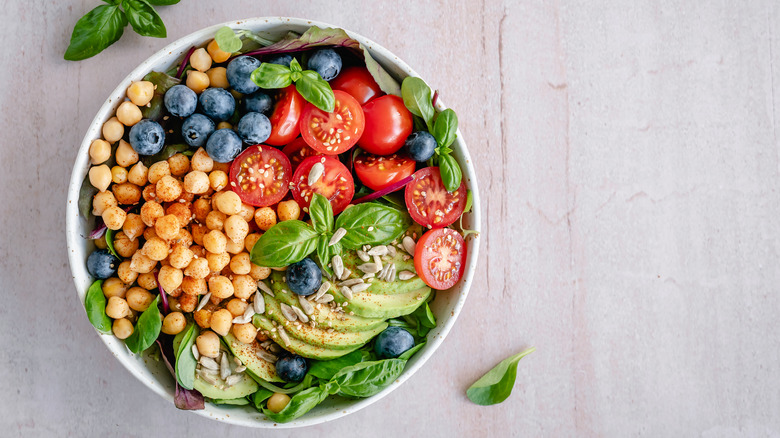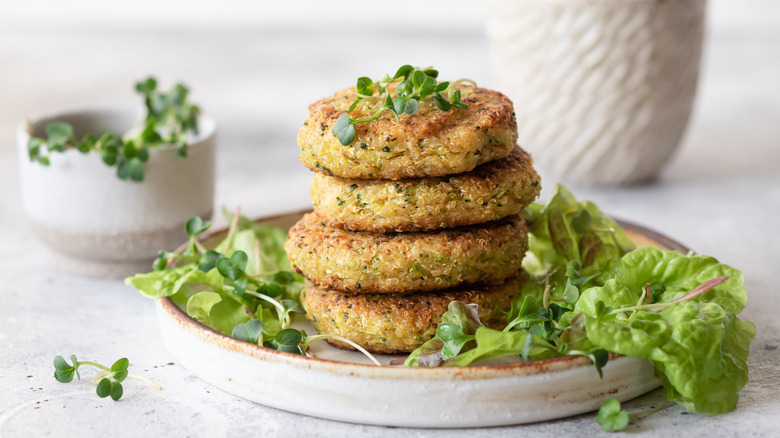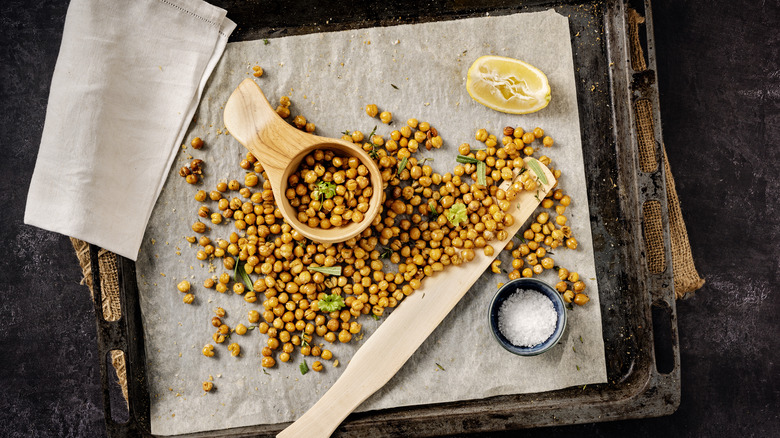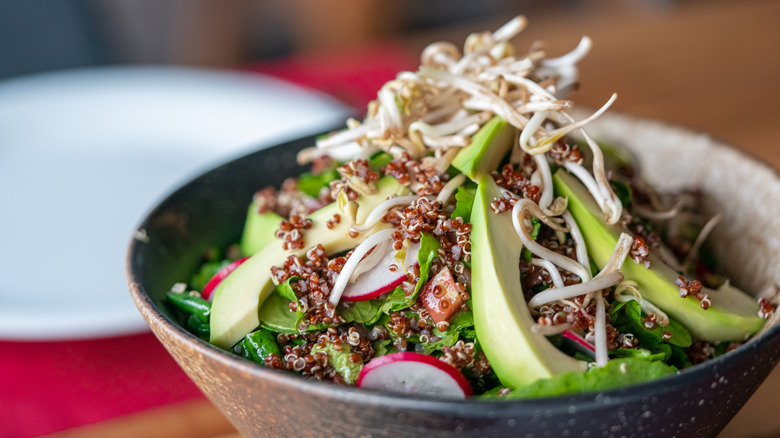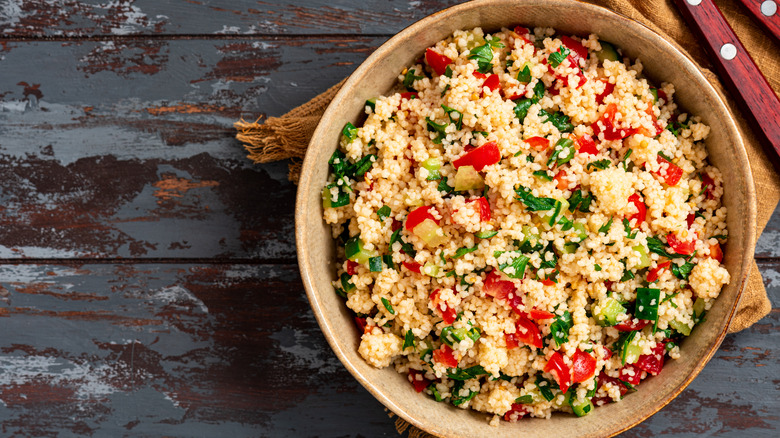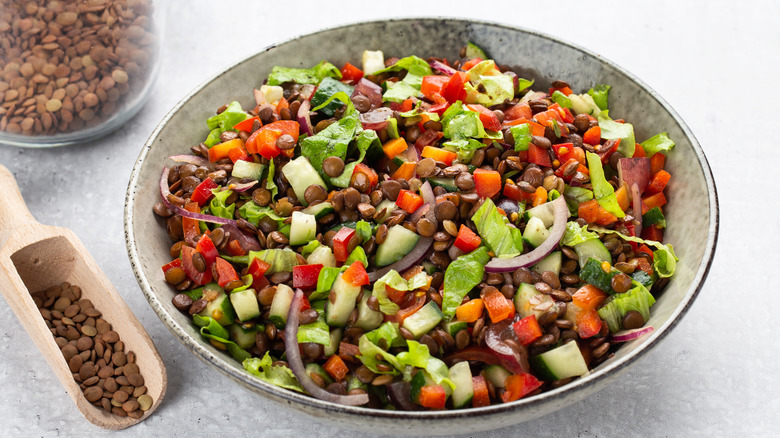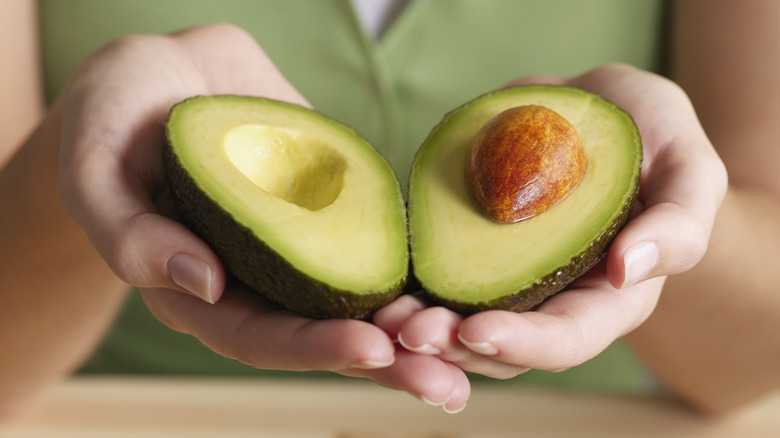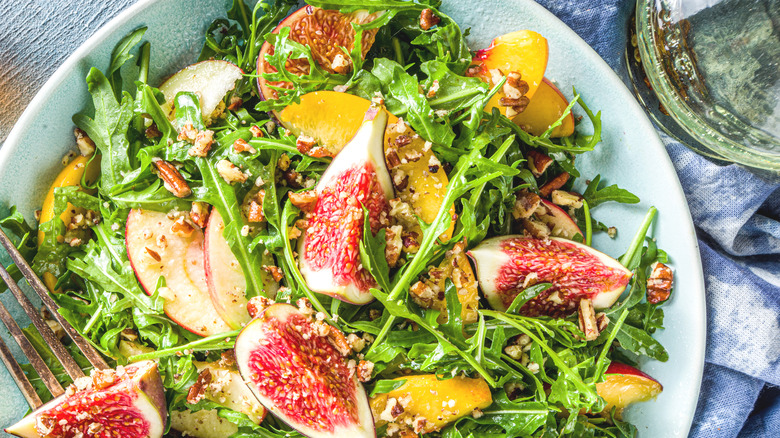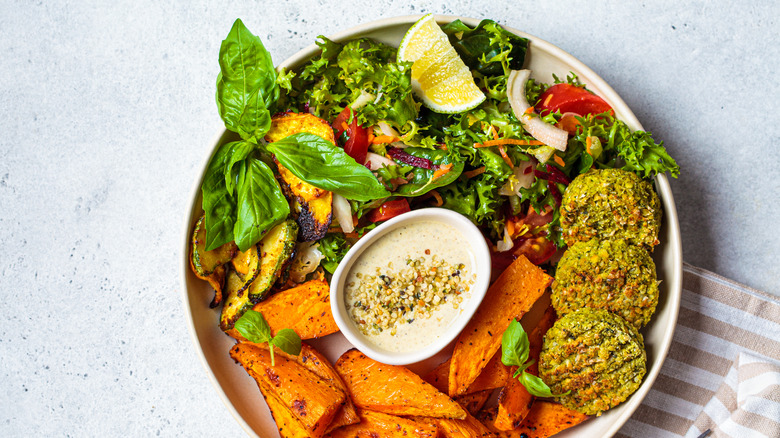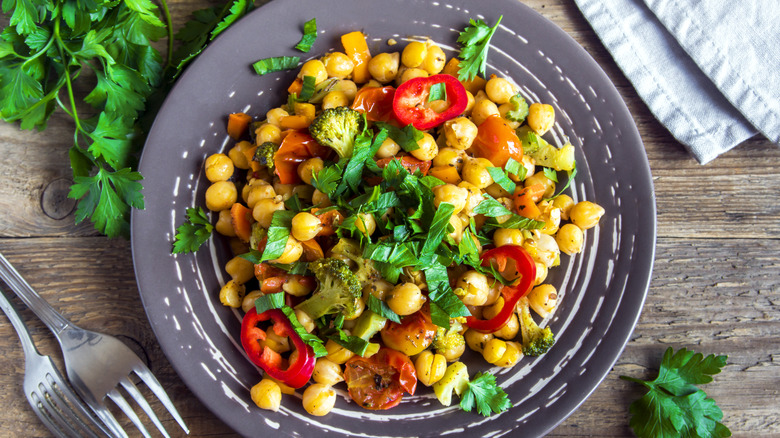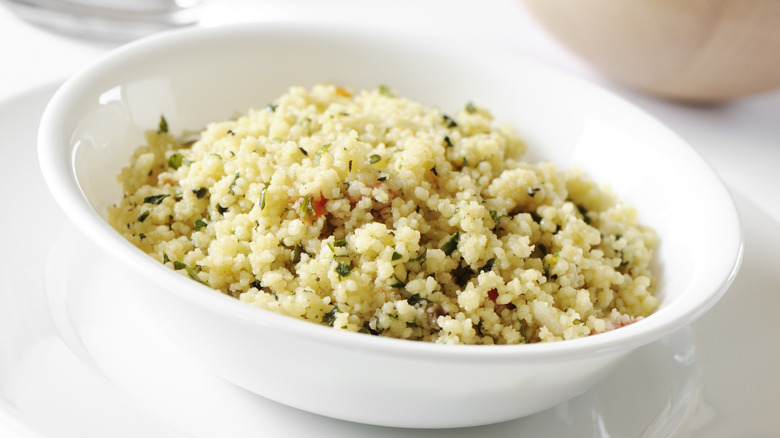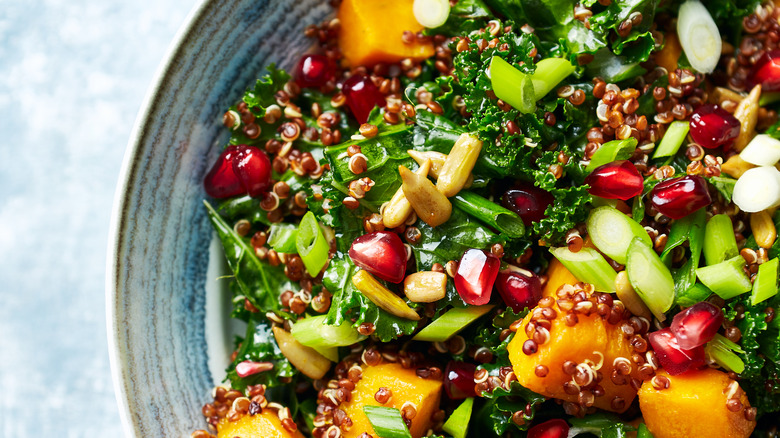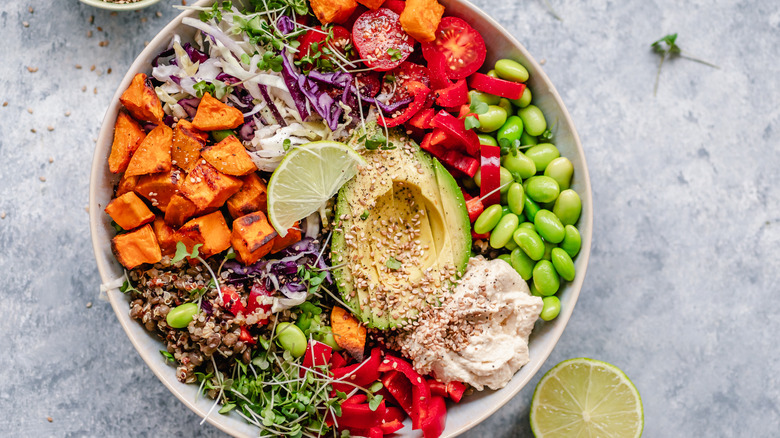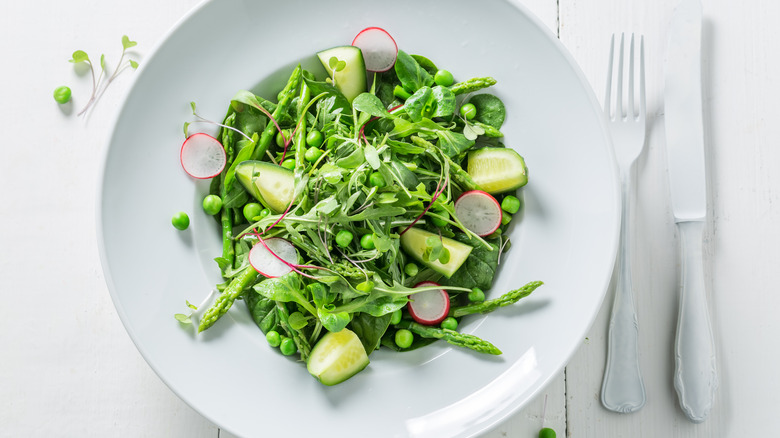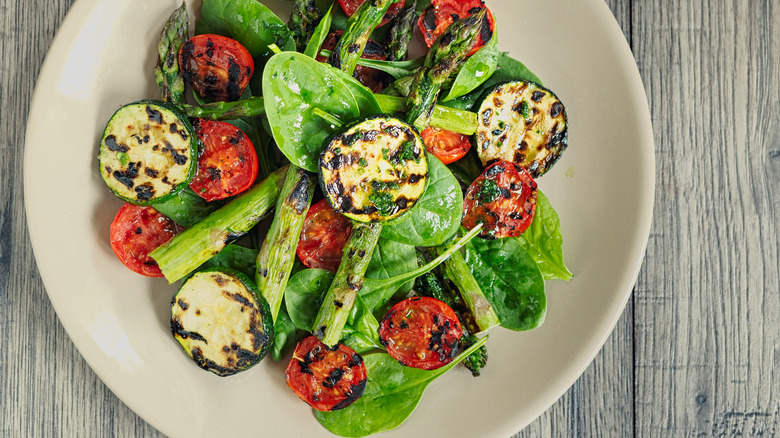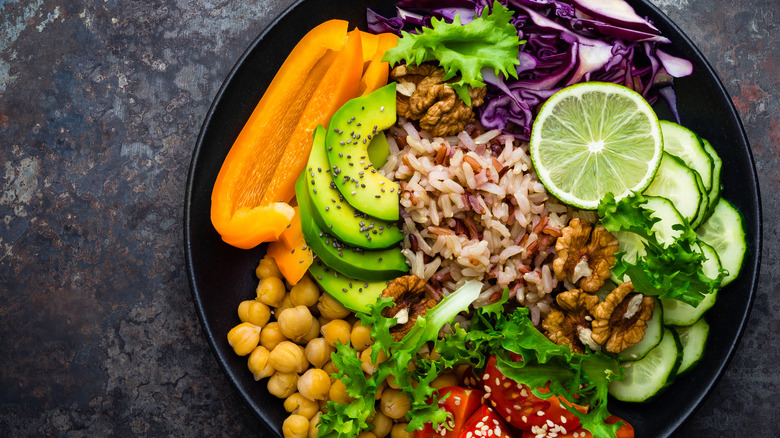15 Vegan Ways To Beef Up Your Dinner Salad
Typically, when we think of a dinner salad, we think of a broad bowl, loaded to the brim with leafy greens, nuts, artisanal cheese, and of course that large slab of meat. Restaurants usually give you the option of grilled shrimp, sliced steak, chicken breast, or salmon as your protein. But what are you supposed to do as a vegetarian or vegan? As a demographic of individuals who consume quite a bit of salad, it's important to know all of the various vegan ways to beef up your dinner salad — no pun intended.
No more will you try to satisfy your hunger with leafy greens, shredded carrots, and cherry tomatoes alone. Newsflash: That's called a side salad, and really it barely even passes for that. It's also known as rabbit food, and it's the stereotypical dish that non-vegans picture you eating when you tell them you're vegan.
Let's break stereotypes and learn to make loaded, heavy, protein-packed salads that can fill you up and keep you satisfied until your next meal. Finally, you'll start looking forward to your dinner salad, instead of thinking ahead about what you'll be eating as a side or for dessert. Vegetables are less calorie dense than meats, so it's important to eat enough in order to fuel your body. Start making the biggest, baddest, loaded vegan dinner salads, sans meat, and never leave the table hungry again.
1. Top with a veggie patty
When it comes to toppings, it is important to avoid tunnel vision. Just because you've selected your featured topping, doesn't mean you can't mix, match, and pair as many as you'd like. The key is to be sure that they all fit a similar flavor theme, or that they go together. Luckily, veggie patties are incredibly versatile and can be made with varying ingredients to fit almost any palate or theme. They are a great replacement for traditional meat protein because they are visually similar to what a typical dinner salad may look like.
While you can certainly choose a meat replacer like Impossible or Beyond Meat, consider making your own vegetable-based patty. If you're a well-versed home cook, then you might have a go-to patty recipe that you love. Others may have to follow a recipe or formula. Vegan veggie patties can be loaded with beans, nuts, seeds, veggies, grains, and even fruits. Read up on the best nuts to use for vegan burgers and the best binders for vegan burgers, so that your patties can be hearty, protein-packed, and well-formed.
2. Add crispy garbanzos
Anyone who has been vegan for some time knows that garbanzo beans are a savior when it comes to beefing up your dinner salad. These little chickpeas come in so many forms, it's hard to get sick of them. You can blend them into hummus, mash them into patties, dry them into flour, and even air fry them to make crispy chickpeas. When baked, pan-fried, or air-fried with herbs, spices, and olive oil, chickpeas completely transform in texture and flavor. They develop crispy skin and a harder, nut-like interior. They can be incredibly satisfying and should be considered for your dinner salad.
Something that vegan food, and salads in particular, often lack is a variety of textures. Especially if you're eating mostly whole foods, it can be easy to miss the chewy and crispy textures associated with meat. And while crispy garbanzos don't mimic that quality exactly, they certainly add variety and texture to any salad. Start by following a crispy chickpea recipe, and dry and toss those little beans in oil. Top with your favorite seasonings and roast them at a high temperature in your oven until they begin to brown. Toss them on your salad, hot or cold.
3. Mix in cooked quinoa
While ancient grains have taken the United States by storm recently — with quinoa at the forefront — we have to disclose a little secret to you. Quinoa is not actually a grain. It's a seed, masquerading and trying to fit in with farrow, barley, buckwheat, and millet. That's why when you cook it, you can see its small little tail that's actually a sprout growing out from the seed. All of that aside, quinoa is an incredible addition to beef up your dinner salad because not only is it hearty, protein and fiber-rich, and delicious, but it clings beautifully to salad dressing which can help to elevate the overall flavor of the dish.
Consider tossing in some leftover, refrigerated quinoa to your dinner salad, or warm quinoa to your hot salad made with dark leafy greens. Alternatively, flavor your quinoa before adding it. Cook it in vegetable broth, mix it with tahini or dressing, or try making Thai quinoa salad to scoop on top of your greens.
4. Include tabbouleh
If you've chosen a Middle Eastern or Mediterranean theme for your salad, then the perfect vegan addition to beef it up is homemade tabbouleh. Tabbouleh is typically made with bulgar; freshly minced herbs like parsley, mint, and green onion; finely chopped cucumber and tomato; and of course, a generous amount of olive oil, garlic, and lemon juice. The bulgar, a hearty grain, will add most of the bulk while the herbs and aromatics will contribute bold flavor. Tabbouleh pairs well with tahini, hummus, chickpeas, olives, capers, cucumber, and tomatoes.
Tabbouleh can be mixed right into your salad, but we recommend adding a big old scoop of it right on top for aesthetic appeal. Be sure when you're making your recipe that you're using fresh herbs, which are essential for the best tabbouleh. If you have any gluten-intolerant folks in the house, just be sure to let them know that bulgar is not a gluten-free grain, and they should avoid the dinner salad. Alternatively, you can make tabbouleh with gluten-free grains like quinoa or millet to play it safe.
5. Top with lentils
Vegans are typically rather well-versed in the world of lentils. Not only are they a staple for high-protein vegetarian soup and veggie burgers, but they can be added to pretty much any savory dish. When it comes to adding lentils to beef up your dinner salad, consider which types of lentils to use, and how to cook them.
Red and yellow lentils, especially when they come in split form, tend to dissolve into a slurry, which makes them perfect for recipes like dhal, or soups. However, for your salad, let's avoid that mushy mess and stick to darker, firmer lentils like black or green lentils that tend to keep their form. Cook them in vegetable broth or other seasonings until tender, strain them, and add them cold to your dinner salad. If you'd like to add a little extra punch of flavor, toss them in a tangy dressing before incorporating them into your greens. They will hold onto the flavor nicely, and help distribute it throughout the salad. Believe us, after loading yourself up with lentils, you won't be thinking about your next meal for at least a few hours.
6. Throw on some avocado
Avocados are one of the most versatile fruits out there. They can be whipped with cocoa and maple syrup to make cupcake frosting, mashed to make guacamole, and as we all know, spread onto toast and loaded with toppings to make the most expensive breakfast out there. There's a reason that avocados are at the center of everyone's obsession, and that's because they are rich, fatty, and delicious. Luckily, they are loaded with fiber and nutrients, and when it comes to their fatty interior, it's not the type to stick to your arteries, per the Harvard T.H. Chan School of Public Health.
In addition, avocados make a wonderful addition to add some calorie density to your dinner salad. They are mild in flavor and tend to pair well with a variety of nuts, grains, seeds, vegetables, fruits, and salad dressings. They hold up just as well with a vinaigrette as they do with a cream-based dressing (made from whipped oil or cashews, of course). Blend avocado right into your dressing, or simply slice it over the top. You can even slice an avocado in half, remove the pit, and stuff the little crater with a spoonful of hummus, tabouleh, or any other sauce or spread you enjoy. Just be sure to choose a beautifully ripened avocado, and if you're having trouble finding one at the grocery store, choose an avocado from the bottom of the pile.
7. Load on the nuts
Vegans are nuts about nuts. And why shouldn't they be? They are loaded with plant-based proteins and healthy fats and can be made into the creamiest, heartiest butters around. At your average restaurant, you'll often find candied walnuts as the primary nut source in salads. Sometimes, you'll come across pecans or candied pecans, but we think sticking to those two varieties, especially when they're always coated with sugar, is short-selling their potential.
If you have a Mediterranean-themed salad, load it up with toasted pine nuts. Top a Thai salad with peanuts or cashews. Use pecans for southern-style salads alongside grilled peaches. Add chestnuts when autumn hits, in combination with delicata squash and craisins. Pistachios can be crushed and added to salads that include fresh fruit. And don't forget about almond slivers, which can be included in most vinaigrette-based salads. When in doubt, stick to the most popular types of nuts, but if you're feeling experimental, try using bolder flavors like roasted hazelnuts. All in all, be sure to add nuts in abundance, and even feel free to mix and match. This is a surefire way to bulk up any vegan dinner salad.
8. Add some crunch with falafel
The Middle East really knows what it's doing when it comes to repurposing chickpeas into the most delectable dishes around. For anyone that's ever dipped falafel into hummus, which is essentially chickpeas into more chickpeas, this must ring especially true. And luckily for us, all of these incredible chickpea dishes seem to go beautifully with leafy greens. Falafel, in particular, is a pleasing topping for salad, because it provides contrast in both texture and temperature. Who doesn't love a deep-fried ball of flavored beans? Why should people eating crispy chicken salad have all the fun when it comes to the deep fryer?
You can certainly buy pre-made falafel from most grocery stores, but there's nothing like homemade, and it's not too difficult to make from scratch. Consider, before using canned chickpeas for falafel, that they must be completely dried before you mash them. You can avoid the deep fryer altogether and bake, air fry, or pan fry the little balls of goodness. Pair your falafel salad with fresh herbs, tahini lemon dressing, and juicy fresh vegetables like tomatoes and cucumber.
9. Scoop on some chickpea salad
If you spent your life before becoming vegan enjoying tuna and chicken salad, then it's just about time you discovered the world of chickpea salad. It's essentially the same thing, just without the meat. It can be flavored to your liking, or made into any style, just like the originals. If you prefer a fresher, lighter flavor then try using dill, lemon juice, dill pickles, and parsley. If you like a heavier, sweeter salad then include walnuts, vegan mayonnaise, tarragon, and craisins or grapes. Never forget the essentials like minced celery, fork-mashed chickpeas, dijon mustard, and garlic powder.
You can get even fancier with it and make curried chickpea salad, or Moroccan chickpea salad recipes. This can include bold spices like curry and turmeric, lemon juice, and raisins for sweetness. Take a big ol' scoop of freshly mashed chickpea salad and add it to the top of your dressed leafy greens. Don't forget to load the salad with additional vegetables like chopped red pepper and red onion.
10. Mix in freshly cooked couscous
If you're used to cooking with rice and quinoa but are looking for a change of pace, try adding couscous to your next dinner salad. It's a hearty grain that comes in little ball-like, white pieces. It has a similar mouthfeel as pasta, and won't get totally lost in a pile of greens. In addition, couscous adds a beautiful aesthetic to salad and can be paired with both robust and delicate toppings.
Consider flavoring your couscous before adding it to the salad. Toss the cooked grain in the dressing while it's cooling, or try mixing it with lemon juice, olive oil, and freshly minced garlic. When in doubt, follow a recipe like the one for this delectable Israeli couscous salad. You can also cook couscous in vegetable broth or flavored water to infuse it with flavor. Be sure to warn your gluten-free friends of the addition, as couscous is not a gluten-free grain.
11. Sprinkle on seeds
While seeds are small, they pack a punch when it comes to nutrients and bulk, especially when added to salad. In addition, they can help to add a variety of textures and a heartier, fattier mouthfeel than you typically get with a traditional raw vegetable-based salad. And when it comes to seed variety and options, the list goes on and on.
For a heartier, larger, and more common seed try roasted pumpkin seeds and sunflower seeds. Both are oily and tender and carry their own unique flavor. Pumpkin seeds often pair nicely with fall-time toppings like delicata squash, nuts, dark leafy greens, dried fruits, and grains, while sunflower seeds tend to accompany summer selections like fresh or grilled fruits, tender crispy greens, and citrus-based vinaigrettes. For a more subtle yet nutty flavor, sprinkle on ground flaxseed. It will absorb some of the dressing and cling beautifully to the green leaves. All in all, there are endless seeds you should be cooking with.
12. Scoop on some hummus
It's not unusual to add dips and sauces to salad. Pesto? Yes, please. Tapenade? Load it on! Hummus? Heck, yeah. Hummus in particular is a hearty addition to dinner salads that's a bit more common than some of our other additions that made the list. While hummus traditionally accompanies Middle Eastern and Mediterranean cuisine, there are plenty of ways to alter the flavors so that they can fit almost any theme or profile. Who says you have to stick to a simple creamy hummus recipe?
If your salad is light and refreshing, load up on lemon juice and add a touch of maple syrup. If it's artisanal and packed with freshly pickled vegetables, try including minced dill pickles, fresh dill, pickle juice, and slivers of pickle garlic. If your salad is fruity or autumn themed, try blending freshly roasted beets into your chickpeas. The options are endless, and the result is filling and delicious.
13. Include fresh peas
Everyone seems to be doing peas wrong. They grab a bag from the freezer section of the grocery store and microwave it into oblivion. Avoid believing the lie that peas are bland and starchy, and start following some critical tips you need when cooking with peas, that will result in sweet little pearls of flavor. In fact, you can avoid cooking them altogether and include fresh peas in your summer salads.
Peas, like most vegetables, are best in flavor and nutrient density when freshly picked. After shelling your peas, sprinkle them into your salad alongside, well, pretty much anything. Peas are versatile and pair particularly well with fruits like stone fruits and strawberries. They can also hold their own next to denser and more robust selections like roasted mushrooms. In addition to being sweet, grassy, and crunchy, fresh peas make an aesthetically beautiful addition to summer salads, particularly when paired with radishes and sprouts.
14. Top with grilled vegetables
There's no better icon of summer than a hot, fired-up grill. We hope you didn't give away your grill when you gave up meat because there are plenty of vegetables and fruits that would love a spot on the scalding hot grates. And even though we don't often associate grilled vegetables or hot food in general with salad, we believe that topping your vegan dinner salad is a great way to beef it up.
Consider grilling robust vegetables like Brussels sprouts, broccoli, cauliflower, or mushrooms. Although, really, any grilled vegetable and even many fruits could enhance your salad. However, more fiber or protein-rich options might be more filling in the long run. There are plenty of ways to add more flavor to mushrooms, broccoli, and cauliflower besides just loading on the salt and pepper. Try marinating them in tamari, balsamic vinegar, or salad dressing before subjecting them to their fiery doom. Add them pipping hot or chilled to your dinner salad.
15. Layer in brown rice
As we know, grains make a fantastic addition to salad and are a great way to add a little bulk that sticks to your ribs. And while there are plenty of options out there, we'd like to make a pitch for plain old rice. Well, brown rice in particular. While white rice is versatile and of course very popular, brown rice contains more nutrients, fiber, and protein, per the Cleveland Clinic. It also has a strong aroma and flavor and is quite chewy.
Be sure to cook your rice to perfection if you plan to add it to your salad. You'll want to avoid overcooking it because a gloopy mess will tend to be rather starchy and clump up. Instead, you can follow the no-frills method for cooking perfect brown rice every time, which you can accomplish using your oven. Brown rice is nutty and mild and pairs well with most vegetables, nuts, and seeds. It tends to complement heartier and darker leafy greens better than delicate and crispy ones.
